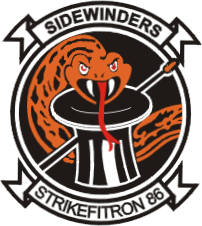
Strike Fighter Squadron 86 (VFA-86) is a strike fighter squadron of the United States Navy based at Naval Air Station Lemoore, California. The squadron is nicknamed Sidewinders, leading to the call sign Winder. The unit currently flies the F/A-18E Super Hornet and is assigned to Carrier Air Wing Seven, tail code AG.
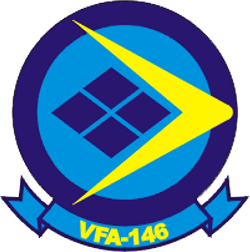
Strike Fighter Squadron 146 (VFA-146) also known as the "Blue Diamonds" is a United States Navy operational fleet strike fighter squadron based at Naval Air Station Lemoore California. They fly the F/A-18E Super Hornet and are attached to Carrier Air Wing 17, deployed aboard USS Nimitz. Their tailcode is NA and their radio callsign is Diamond.

Strike Fighter Squadron 113 (VFA-113), also known as the "Stingers," is a United States Navy strike fighter squadron based at Naval Air Station Lemoore, California. They are an operational fleet F/A-18E Super Hornet squadron attached to Carrier Air Wing 2 (CVW-2) and based at NAS Lemoore, California. Their tailcode is NE and their radio callsign is Sting.

Strike Fighter Squadron 81 (VFA-81), also known as the "Sunliners", is a United States Navy F/A-18E Super Hornet strike fighter squadron stationed at Naval Air Station Oceana. They are a part of Carrier Air Wing One, their radio callsign is Inferno, and their tail code is AB. Their mission is to conduct prompt and sustained combat operations from the sea. The squadron was originally designated VA-66 on 1 July 1955, was redesignated VF-81 the same day, redesignated VA-81 on 1 July 1959, and finally redesignated VFA-81 on 4 February 1988.

VA-106 was an Attack Squadron of the U.S. Navy. Originally established as Bomber-Fighter Squadron Seventeen (VBF-17) on 2 January 1945, it was redesignated Fighter Squadron Six B (VF-6B) on 15 November 1946, redesignated VF-62 on 28 July 1948, redesignated Attack Squadron 106 (VA-106) on 1 July 1955, it was disestablished on 7 November 1969. It was the second US Navy squadron to be designated VA-106.

VA-55 was an Attack Squadron of the U.S. Navy. It was established as Torpedo Squadron VT-5 on 15 February 1943, redesignated VA-6A on 15 November 1946, and finally designated VA-55 on 16 August 1948. The squadron was disestablished on 12 December 1975. It was the first squadron to be designated VA-55, the second VA-55 was established on 7 October 1983 and disestablished on 1 January 1991.
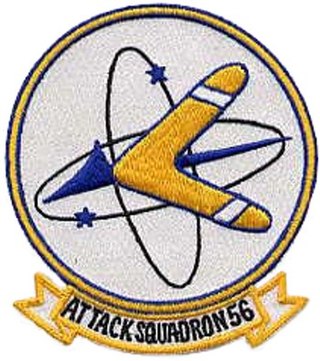
VA-56 was an Attack Squadron of the U.S. Navy. It was established on 4 June 1956, and disestablished thirty years later, on 31 August 1986. The squadron's nickname was the Boomerangs from 1957 to 1958, and the Champions thereafter.
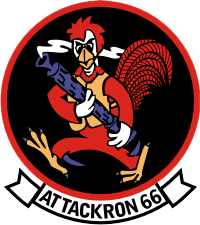
VA-66 was an Attack Squadron of the U.S. Navy; it was the second squadron to be so named. The squadron was called to duty and established as Reserve Fighter Squadron VF-671 on 1 February 1951. It was redesignated Fighter Squadron VF-81 on 4 February 1953, and finally as VA-66 on 1 July 1955. The squadron was disestablished on 1 October 1986, but one detachment continued in existence until 31 March 1987. The squadron's nickname was the Waldomen from the 1950s to the early 1960s, and the Waldos from that point forward. Its insignia, a rooster toting a machine gun, was a well-known design in naval aviation.

VA-76 was an Attack Squadron of the U.S. Navy. It was established on 1 June 1955 and disestablished on 30 September 1969. The squadron was nicknamed the Spirits, from its motto Fighting Spirits of 76.
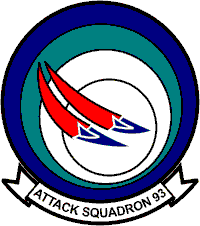
VA-93 was an Attack Squadron of the U.S. Navy. It was established as Fighter Squadron VF-93 on 26 March 1952, and redesignated as VA-93 on 15 September 1956. It was disestablished 30 years later on 31 August 1986. The squadron's nickname was the Blue Blazers from 1954 to 1976 and the Ravens thereafter.

VA-112 was an Attack Squadron of the U.S. Navy. It was established as Bomber-Fighter Squadron VBF-11 on 9 April 1945, redesignated Fighter Squadron VF-12A on 15 November 1946, then as VF-112 on 15 July 1948. It was finally redesignated as VA-112 on 15 February 1959. The squadron was disestablished on 10 October 1969. Its nickname from 1961 to 1969 was the Broncos.

Attack Squadron 145 (VA-145) was an aviation unit of the United States Navy, nicknamed the Rustlers from 1951-1954, and the Swordsmen thereafter. The squadron was established as Reserve squadron VA-702 on 1 December 1949, and called to active duty on 20 July 1950. It was redesignated VA-145 on 4 February 1953, and disestablished on 1 October 1993.
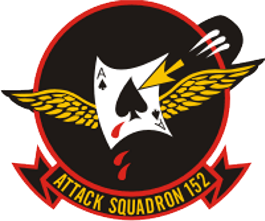
VA-152 was an Attack Squadron of the U.S. Navy, nicknamed the Fighting Aces from 1953-1956, the Friendly Squadron or Friendlies from 1957-1968, and the Mavericks thereafter.

VA-153 was an Attack Squadron of the U.S. Navy. During a 1949 reorganization of the Naval Air Reserve, a Fighter Squadron at NAS New York was redesignated Fighter Squadron VF-831. It was called to active duty on 1 February 1951. The squadron was redesignated as VF-153 on 4 February 1953, and finally as VA-153 on 15 December 1956. It was disestablished on 30 September 1977. The squadron's nickname was the Blue Tail Flies from 1953 onward.

Attack Squadron 155 or VA-155 was an 'Attack Squadron of the U.S. Navy. It was established as Reserve Attack Squadron VA-71E in 1946, redesignated as VA-58A on 1 October 1948, and redesignated Reserve Composite Squadron VC-722 on 1 November 1949. The squadron was redesignated as VA-728 on 1 April 1950, and called to active duty on 1 February 1951. It was ultimately redesignated VA-155 on 4 February 1953, and disestablished on 30 September 1977. Its nickname was Silver Fox from the early 1960s onward. It was the second squadron to be named VA-155, the first VA-155 was disestablished on 30 November 1949, while a third VA-155 was established on 1 September 1987 and disestablished on 30 April 1993.

VA-165, nicknamed the Boomers, was a long-lived Attack Squadron of the U.S. Navy. It was established on 1 September 1960, and disestablished 35 years later on 30 September 1996. The squadron operated in the region of Vietnam, Laos, and Korea during the 1960s and early 1970s. VA-165 transferred to the Persian Gulf after the 1973 Yom Kippur War, and also served near the Philippines during the late 1970s. During the 1980s, VA-165 was moved from the Middle East to Central America, particularly Nicaragua, back to Iran in the Middle East, off to South Korea, and then to the Middle East again for Kuwait. During the 1990s, the squadron worked in the United States, the Middle East, and Taiwan.

VA-172 was an Attack Squadron of the U.S. Navy. It was established as Bomber Fighter Squadron VBF-82 on 20 August 1945, redesignated as Fighter Squadron VF-18A on 15 November 1946, as VF-172 on 11 August 1948, and as VA-172 on 1 November 1955. The squadron was disestablished on 15 January 1971. Its nickname was the Checkmates from 1946-1950, and the Blue Bolts thereafter.
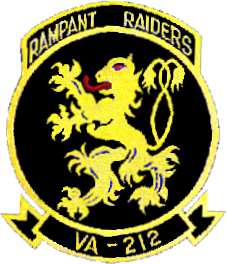
Attack Squadron 212 (VA-212), nicknamed the Rampant Raiders, was an aviation unit of the United States Navy. It was established as Fighter Squadron 212 (VF-212) on 20 June 1955, and redesignated as VA-212 on 1 April 1956. The squadron was disestablished on 12 December 1975.

VA-215, nicknamed the Barn Owls, was an Attack Squadron of the U.S. Navy. It was established 22 June 1955, and disestablished on 31 August 1967.

VA-216, nicknamed the Black Diamonds, was an Attack Squadron of the US Navy. It was established on 30 March 1955, and disestablished 15 years later on 1 August 1970.





















